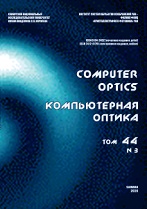|
This article is cited in 2 scientific papers (total in 2 papers)
OPTO-IT
The photonic nanojets formation by two-dimensional microprisms
V. D. Zaitsevab, S. S. Stafeevab
a IPSI RAS – Branch of the FSRC "Crystallography and Photonics" RAS,
443001, Samara, Russia, Molodogvardeyskaya 151
b Samara National Research University, 443086, Samara, Russia, Moskovskoye Shosse 34
Abstract:
Using the finite difference method implemented in the COMSOL Multiphysics software package, the focusing of laser radiation by dielectric prisms with a triangular profile was numerically investigated. It was shown that two-dimensional triangular prisms make it possible to focus light in free space into spots with dimensions smaller than the scalar diffraction limit. In particular, a silica glass prism with a base width of 60 $\mu m$ and a height of 28.5 $\mu m$ forms a photonic nanojet with a maximum intensity of 6 times the intensity of the incident radiation and a width of FWHM=0.38$\lambda$. A prism from barium titanate with a base width of 60 $\mu m$ and a height of 20 $\mu m$ allows to obtain a photonic nanojet with the same width (0.38$\lambda$) and a maximum intensity 5 times the intensity of the incident radiation. The size of the focal spot can be reduced further if the height of the prism is selected so that the maximum intensity is located inside the material of the prism. For example, a barium titanate prism with a height of 21 $\mu m$ and a base width of 60 $\mu m$ forms a focal spot with a width of FWHM=0.25$\lambda$.
Keywords:
photonic nanojet, subwavelength focusing, finite element method, dielectric microprism.
Received: 23.04.2020
Accepted: 06.07.2020
Citation:
V. D. Zaitsev, S. S. Stafeev, “The photonic nanojets formation by two-dimensional microprisms”, Computer Optics, 44:6 (2020), 909–916
Linking options:
https://www.mathnet.ru/eng/co863 https://www.mathnet.ru/eng/co/v44/i6/p909
|

| Statistics & downloads: |
| Abstract page: | 90 | | Full-text PDF : | 33 | | References: | 5 |
|




 Contact us:
Contact us: Terms of Use
Terms of Use
 Registration to the website
Registration to the website Logotypes
Logotypes








 Citation in format
Citation in format 
